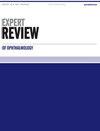Mechanisms of corneal trauma in response to rubbing and other intraocular pressure elevating activities in keratoconus
IF 0.9
Q4 OPHTHALMOLOGY
引用次数: 2
Abstract
ABSTRACT Introduction The potential for eye rubbing to contribute to keratoconus development and progression is well established, but the mechanisms of that association have not been fully elucidated. Areas covered This review examines mechanisms for rubbing-related corneal trauma from both anterior and posterior surface responses to elevated intraocular pressure. Apart from rubbing-related intraocular pressure elevation, consideration is given to other sources of elevation which may contribute to corneal bulging and cone formation. Mechanisms whereby intraocular pressure-related increased posterior corneal surface distending stress and stromal hydrostatic pressure may alter keratocyte functions and increase susceptibility to such stress are examined. Expert opinion Elevated intraocular pressure (IOP) that is associated with a chronic habit of abnormal rubbing (CHAR) can be a major contributor of keratoconus (KC) development and progression. Anterior corneal surface protection during rubbing due to Bell’s reflex in most patients, at least for the central and para-central cornea, increases the likelihood that IOP distending stress can be an important source of KC pathogenesis, perhaps even in patients who do not have abnormal rubbing habits. That the earliest pathological changes in KC occur at the posterior corneal surface is consistent with the significance of an IOP-related distending force mechanism for KC pathogenesis.圆锥角膜摩擦和其他眼压升高活动引起角膜损伤的机制
眼部摩擦促进圆锥角膜发育和进展的可能性已得到充分证实,但这种关联的机制尚未完全阐明。本综述探讨了眼压升高引起的前、后表面摩擦相关角膜创伤的机制。除了与摩擦相关的眼压升高外,还考虑到其他可能导致角膜膨出和锥体形成的升高来源。眼压相关的后角膜表面膨胀应力和间质静水压力增加可能改变角质细胞功能并增加对这种压力的易感性的机制进行了研究。专家意见:眼压升高与慢性异常摩擦(CHAR)习惯相关,可能是圆锥角膜(KC)发展和进展的主要因素。在大多数患者中,至少对于中央和中心旁角膜,由于贝尔反射,在摩擦过程中角膜前表面的保护增加了IOP膨胀压力可能是KC发病的重要来源的可能性,甚至可能在没有异常摩擦习惯的患者中也是如此。KC的病理改变最早发生在角膜后表面,这与眼压相关的扩张力机制在KC发病中的意义是一致的。
本文章由计算机程序翻译,如有差异,请以英文原文为准。
求助全文
约1分钟内获得全文
求助全文
来源期刊

Expert Review of Ophthalmology
Health Professions-Optometry
CiteScore
1.40
自引率
0.00%
发文量
39
期刊介绍:
The worldwide problem of visual impairment is set to increase, as we are seeing increased longevity in developed countries. This will produce a crisis in vision care unless concerted action is taken. The substantial value that ophthalmic interventions confer to patients with eye diseases has led to intense research efforts in this area in recent years, with corresponding improvements in treatment, ophthalmic instrumentation and surgical techniques. As a result, the future for ophthalmology holds great promise as further exciting and innovative developments unfold.
 求助内容:
求助内容: 应助结果提醒方式:
应助结果提醒方式:


